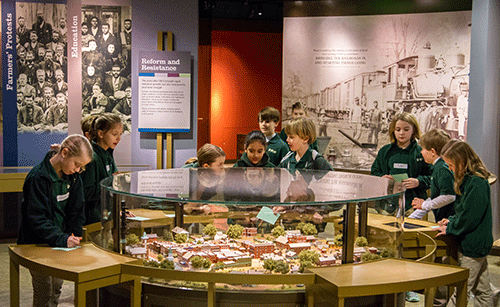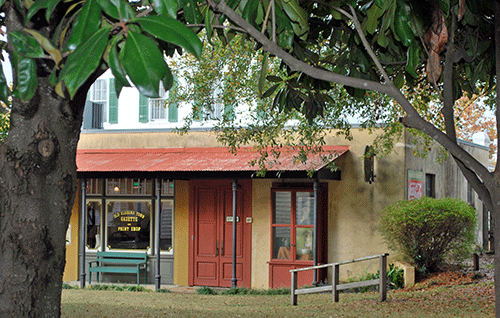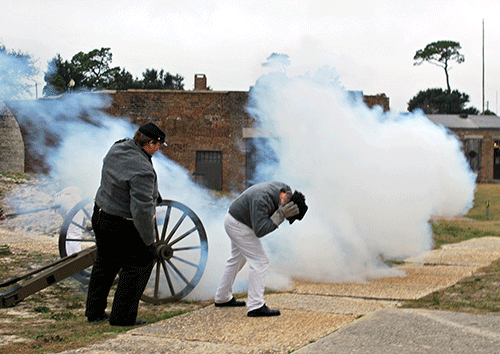
By Marilyn Jones
I stand at the top of the Alabama State Capitol steps in Montgomery. Just around the corner to my right is a statue of Confederate President Jefferson Davis. Directly on the other side of the building are the flags of every state in the Union. Down the block is Dexter Avenue King Memorial Baptist Church where a young Martin Luther King served as pastor. And the street straight in front of me is where Selma to Montgomery marchers approached the Capitol seeking voter’s rights in 1965.
Alabama is like this; everywhere there are landmarks pointing to its history dating back to Native Americans, the first European explorers and settlers, the Civil War and civil rights.
Like a great novel, there are many plot twists, characters, places and events. But unlike a good book, we can visit history. It’s all around us; as close as a museum or historic site. As close as the State Capitol where so many significant events took place.
By introducing children to the past, we’re providing them a chance to time-travel; fueling their curiosity and helping them better understand Alabama and American history.
The First Alabamians
The Chattahoochee Indian Heritage Center in Fort Mitchell chronicles the Creek Native Americans, who, for centuries, lived here until they faced the assault of Spanish, English and French explorers and settlers.
The Creek War of 1813-1824 and the Creek War of 1836 crippled the Creek Nation resulting in their forced journey west on the Trail of Tears. Thousands of men, women and children died along the way.
The heritage center remembers this tragic time in history as well as celebrates the culture of the Native Americans who inhabited Chattahoochee Valley.

just one of the historic buildings open for touring.
European occupation
In 1540 Spanish explorer Hernando DeSoto, accompanied by an army of 600 men, first set foot in what is now Alabama. This was the beginning of European occupation, which lasted until Alabama became a territory in 1817 and then the 22nd state on Dec. 14, 1819.
According to the most recent historic information, the Spaniards entered Alabama along the Coosa River and followed it to what is today Childersburg. DeSoto’s expedition spent a little more than five weeks in the Coosa Indian capital.
The mission had two major objectives, to find gold and to establish the first Spanish colony in the New World. The head of the Coosa Nation welcomed DeSoto during a ceremony that took place near the entrance of DeSoto Caverns.
It ended badly for the Micco, or chief, who offered DeSoto territory to establish a colony. DeSoto, in turn, refused. He had come for gold and took the Micco hostage, enslaved some of the Coosa people and raided their supplies.
The French and English followed the Spanish into Alabama, pushing out Native Americans and establishing forts and communities.
There is a lot to learn about the Childersburg area. A fun place to start is DeSoto Caverns Park. In addition to DeSoto’s journey, cave guides explain how saltpeter was mined in the cave and used to make gunpowder for the Confederate Army during the Civil War, and that the cave was later used as a speakeasy during prohibition.
Civil War and civil rights
From the Montgomery inauguration of Confederate President Jefferson Davis in 1861 to Fort Morgan and Fort Gaines protecting Mobile Bay, Alabama has numerous Civil War sites to ignite any child’s curiosity about the war, the politics behind the state’s secession from the Union and slavery.
To further enlighten young minds about slavery, there are several plantations open for tours, each further examining the institution of slavery which factored into Alabama’s decision to secede from the Union in 1861. The Montgomery-Janes-Whittaker House, best known today as Buena Vista, is located south of Prattville and operates as a house museum.

Fort Gaines.
A century after the Civil War, Alabama made history as the center of many civil rights events that would bring about positive change in this nation. One of the best sites to visit to better understand the civil rights movement — past and present — is the Civil Rights Memorial & Center in Montgomery.
A feature of the center is the Civil Rights Memorial which honors the achievements and memory of those who died during the civil rights movement between the Brown vs. Board of Education decision in 1954 and the assassination of Dr. Martin Luther King in 1968.
Tying it all together
One destination that puts the state’s history over the past 300 years into clear focus is the Museum of Alabama at the Alabama Department of Archives and History in Montgomery.
A new gallery, “Alabama Voices,” chronicles the past 300 years of state history beginning with Native American Creeks and newly arriving Europeans. The visual narrative continues through the early years of statehood up until the Civil War: the logistics and economics; the emotions, anxiety and fear.
“Mine, Mills and Mules” follows the years of reconstruction – the growth of railroads, textile and lumber industries, iron production and farm families all leading up to the disastrous economic failure of the 1930s during the Great Depression followed by the New Deal and WW II.
The civil rights movement culminates the new state-of-the-art museum that uses everything at its disposal from priceless artifacts and maps to touch-screen computers and video monitors to tell the state’s story.
Old Alabama Town in Montgomery is another excellent attraction to help children visualize the past. Covering six blocks, the 19th century village features houses original to the neighborhood and others moved here from other locations throughout the state. Costumed docents add to the village’s charm.




